
The radial engine is a reciprocating type internal combustion engine configuration in which the cylinders "radiate" outward from a central crankcase like the spokes of a wheel. It resembles a stylized star when viewed from the front, and is called a "star engine" in some other languages.

The Douglas DC-6 is a piston-powered airliner and cargo aircraft built by the Douglas Aircraft Company from 1946 to 1958. Originally intended as a military transport near the end of World War II, Douglas reworked it after the war to compete with the Lockheed Constellation in the long-range commercial transport market. Douglas built over 700, and many still fly in cargo, military, and wildfire control roles.
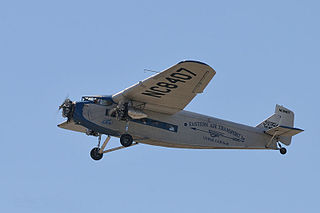
The Ford Trimotor is an American three-engined transport aircraft. Production started in 1925 by the companies of Henry Ford and ended on June 7, 1933, after 199 had been made. It was designed for the civil aviation market, but also saw service with military units.

The Cessna 180 Skywagon is a four- or six-seat, fixed conventional gear general aviation airplane which was produced between 1953 and 1981. Though the design is no longer in production, many of these aircraft are still in use as personal aircraft and in utility roles such as bush flying.
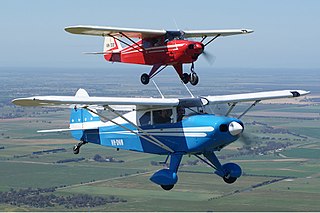
The PA-20 Pacer and PA-22 Tri-Pacer, Caribbean, and Colt are an American family of light strut-braced high-wing monoplane aircraft built by Piper Aircraft from 1949 to 1964.

The Cessna 177 Cardinal is a light single-engine, high-wing general aviation aircraft produced by Cessna. It was intended to replace the Cessna 172 Skyhawk. First announced in 1967, it was produced from 1968 to 1978.
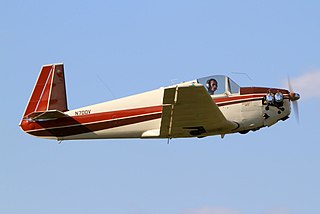
The Mooney M-18 "Mite" is a low-wing, single-place monoplane with retractable, tricycle landing gear.

The aircraft diesel engine or aero diesel is a diesel-powered aircraft engine. They were used in airships and tried in aircraft in the late 1920s and 1930s, but were never widely adopted until recently. Their main advantages are their excellent specific fuel consumption, the reduced flammability and somewhat higher density of their fuel, but these have been outweighed by a combination of inherent disadvantages compared to gasoline-fueled or turboprop engines. The ever-rising cost of avgas and doubts about its future availability have spurred a resurgence in aircraft diesel engine production in the early 2010s.

An electric aircraft is an aircraft powered by electricity. Electric aircraft are seen as a way to reduce the environmental effects of aviation, providing zero emissions and quieter flights. Electricity may be supplied by a variety of methods, the most common being batteries. Most have electric motors driving propellers or turbines.

The de Havilland Gipsy is a British air-cooled four-cylinder in-line aircraft engine designed by Frank Halford in 1927 to replace the ADC Cirrus in the de Havilland DH.60 Moth light biplane. Initially developed as an upright 5 litre capacity engine, later versions were designed to run inverted with increased capacity and power.

The Morane-Saulnier MS.230 aircraft was the main elementary trainer for the French Armée de l'Air throughout the 1930s. Almost all French pilots flying for the Armée de l'Air at the outbreak of World War II had had their earliest flight training in this machine. It was the equivalent of the Stearman trainer in the United States air services and the de Havilland Tiger Moth in the British Royal Air Force.

The Weedhopper is an American high-wing, tractor configuration, tricycle gear, two-axis control ultralight aircraft originally developed by John Chotia during the height of the 1970s ultralight boom and introduced in 1977. When it was in production the aircraft was sold as a kit for amateur construction and could be assembled in 25-30 man-hours.
The Avid Champion is an American single-seat, high-wing ultralight aircraft that was produced starting in 1998 as a kit by Avid Aircraft of Caldwell, Idaho, later Ennis, Montana.

The Murphy JDM-8 is a Canadian single-seat ultralight monoplane designed by Daryl Murphy. The type was intended to be sold as a kit for home construction by Murphy Aircraft of Chilliwack, British Columbia.
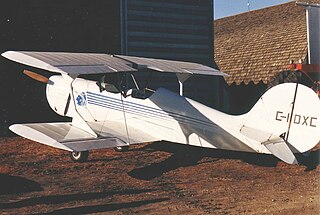
The Murphy Renegade is a family of Canadian two-seats-in-tandem, single engine, conventional landing gear, biplanes, produced by Murphy Aircraft and intended for amateur construction.
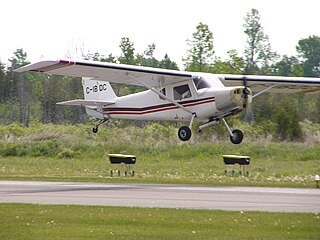
The Ultravia Pelican is the name given to two series of high-wing, single-engine, tractor configuration ultralight aircraft that were designed by Jean Rene Lepage and produced in kit form for amateur construction by Ultravia Aero International of Mascouche, Quebec and later Gatineau, Quebec.

The Earthstar Thunder Gull is a family of cantilever high-wing, tricycle gear ultralight aircraft, manufactured by Earthstar Aircraft of Santa Margarita, California as a kit for amateur construction or as a completed aircraft.

The Viking SF-2A Cygnet, also called the Sisler SF-2A Cygnet and the HAPI SF-2A Cygnet, is an American STOL amateur-built aircraft, designed by Bert Sisler and produced by Viking Aircraft LLC. The aircraft is supplied in the form of plans for amateur construction. The Cygnet first flew in 1973.
The Fly Castelluccio Diavolo is an Italian powered parachute that was designed and produced by Fly Castelluccio Paramotor Paragliding and Trike srl of Ascoli Piceno. Now out of production, when it was available the aircraft was supplied as a complete ready-to-fly-aircraft.

Winds Italia was an Italian aircraft manufacturer based in Bologna that was founded by Canadian hang glider champion pilot Randy Haney. The company specialized in the design and manufacture of paramotors and powered hang glider harnesses in the form of ready-to-fly aircraft for the US FAR 103 Ultralight Vehicles rules and the European microlight category.


















